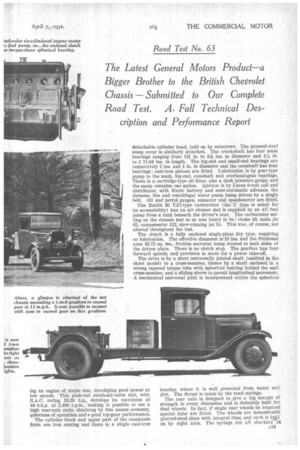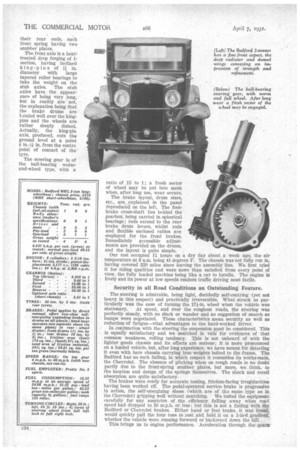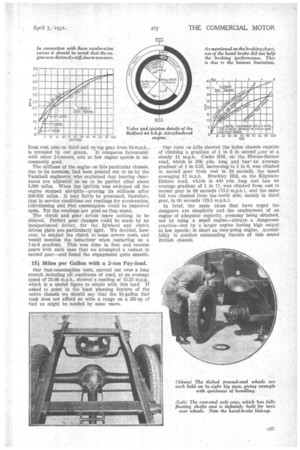The New
Page 70

Page 71

Page 72

Page 73

If you've noticed an error in this article please click here to report it so we can fix it.
BEDFORD 2-TONNER for Great Britain
THE intention of Vauxhall Motors, Ltd., Luton, which is a branch of the General Motors, Ltd., organization, to make a big bid for export trade with a range of moderately priced commercial vehicles, made at the Luton works, was first announced in our issue dated January 27th, when we indicated that the 2-tonners would probably soon be available in Great Britain.
A rumour has been heard in different parts of the country that the Luton-built Chevrolet 30-chassis, so exceedingly popular, would then pass out of production. This was denied in our issue dated February 17th. 'There is not an atom of truth in such stories. The Bedford is in a different class, having a Vauxhall overheadvalve engine with four-bearing crankshaft, a full-floating rear axle and other features of distinction. Both Bedford and Chevrolet are British built chassis throughout.
As announced briefly last week, the two Bedford 2-tonners are now to be available here, the prices being £198 for the shortwheelbase and £210 for the long-wheelbase models, as compared with £175 for the Chevrolet 30-cwt. chassis. The Chevrolet dealer organization throughout Great Britain and the Irish Free State will handle Bedford sales and service.
The principal differences between the two Bedford models are:— Chassis price ... Wheelbase Dash to end of frame ... Overall chassis length ... Body length behind driver chassis weight (dry) ...
••• ••• ••• ••• ..!
Type WHS. £198 10 ft. 11 ins.
11 ft. 413ins.
15 ft. 7 9-16 ins. 8 ft. 4 ins.-9 ft. 27 cwt. 26 lb.
f210T.ype WHL. 13 ft. 1 in.
14 ft. 10in.
17 ft. 9 9-16 ins. 11 ft.-11 ft. 6 ins. 28 cwt. 14 lb.
Dimensions common to the two lengths of Bedford 2-ton chassis are : front track, 4 ft. 9 ins.; rear track (between twin tyres), 5 ft. 1 in.; frame height (laden), 2 ft. Oi in.; axle clearance (back) 9 ins., (front) 91 ins.; frame width (rear), 3 ft. 1/ in.; front springs, 3 ft. by 1 in. (eight leaves) ; rear springs, 3 ft. 9 ins. by 21, ins. (17 leaves).
We have watched one of the first Bedford chassis, a long-wheelbase type, through the stages of its initial c32
trials, and it has been placed at our disposal for examination and submission to our standard road test. The maximum frame section is 7 ins. by 2-/ ins. by 7-32 in. and there are six pressed-steel hot-riveted cross-members, affording ample rigidity. The enginegearbox unit has three-point suspension, the two rear _ bearers being mounted in rubber. The aim of the designers, obviously, has been the wise one of employ detachable cylinder head, held on by setscrews. The pressed-steel sump cover is similarly attached. The crankshaft has four main bearings ranging from 114 in. to 2A ins. in diameter and 117, to 2 11-64 ins, in length. The big-end and small-end bearings are respectively 2 ins. and 1 in. in diameter and the camshaft has four bearings ; cast-iron pistons are fitted. Lubrication is by gear-type pump to the main, big-end, camshaft and overhead-gear bearings. Thereis a cartridge-type oil filter, also a dash pressure gauge, and the sump contains one gallon. Ignition is by Lucas 6-volt coil and distributor, with Exide battery and semi-automatic advance, the dynamo, fan and centrifugal water pump being driven by a single belt. Oil and petrol gauges, ammeter and speedometer are fitted.
The Zenith 30 UJ2-type carburetter (the U type is noted for its accessibility) has an air cleaner and is supplied by an A'C fuel pump from a tank beneath the driver's seat. The carburetter setting on the chassis lent to us was fond fo be choke 19, main jet 65, compensator 122, slow-running jet 55. This was, of course, not altered throughout the test.
The clutch is a fully enclosed single-plate dry type, requiring no lubricatio'n. The effective diameter is 10 ins, and the frictional • area 85.72 sq. ins., friction material being riveted to both sides of the driven plate. There is no clutch stop. The gearbox has four forward speeds, and provision is made for a power take-off.
The drive is by a short universally jointed shaft (omitted in the short model) to a cross-member, thence by a shaft enclosed in a strong tapered torque tube with spherical bearing behind the said cross-member, and a sliding sleeve to permit longitudinal movement. A mechanical universal joint is incorporated within the spherical
ing an engine of ample size, developing good power at low speeds. This push-rod overhead-valve unit, with R.A.C. rating 26.33 h.p., develops its maximum of 44 b.h.p. at 2,400 r.p.m., making it possible to use a high rear-axle ratio, obtaining by this means economy, quietness of operation and a good top-gear performance.
The cylinder block and upper part of the crankcase form one iron casting and there is a single cast-iron
bearing, where it is well protected from water and dirt. The thrust is taken by the road springs.
The rear axle is designed to give a big margin of strength in every dimension and is definitely built for dual wheels. In fact, if single rear wheels be required special hubs are fitted. The wheels are demountable pierced-steel discs with integral rims, and each is hg,d on by eight. nuts. The springs are all shackled' at their rear ends, each front spring having two snubber plates.
The front axle is a heattreated drop forging of Isection, having inclined. king-pins of -F2in. diameter with large tapered roller bearings to take the weight on the stub axles. The stub axles have the appearance of being very long, but in reality are not, the explanation being that the brake drums are 1:cated well over the kingpins and the wheels are rather deeply dished. Actually, the king-pin axis, produced, cuts the ground level at a point
in.--Hr in. from the centre point of contact of the ' tyre.
The steering gear is of the ball-bearing wormand-wheel type, with a ratio of 15 to 1; a fresh sector of wheel may be put into mesh when, after long use, wear occurs.
The brake layout, drum sizes, etc., are explained in the panel reproduced on the left. The footbrake cross-shaft lies behind the gearbox, being carried in spherical bearings; rods extend to the rear brake drum levers, whilst rods and flexible enclosed cables are employed for the front brakes. Immediately accessible adjust ments are provided on the drums, and the layout is quite simple.
Our test occupied 11 hours on a dry day about. a week ago, the air temperature at 8 a.m. being 41 degrees F. The chassis was not fully run in, having covered 320 miles since leaving the assembly line. We first tried it for riding qualities and were mare than satisfied from every point of view, the fully loaded machine being like a car to handle. The engine is lively and its power at low speeds renders traffic driving most facile.
Security in all Road Conditions an Outstanding Feature.
The steering is admirable, being light, decidedly self-centring (yet not heavy in this respect) and practically irreversible. What struck us particularly was the ease of turning the 17i-in. wheel when the vehicle was stationary. At speed, and over the roughest roads, the steering was perfectly steady, with no slack or wander and no suggestion of-snatchas bumps were negotiated. These characteristics mean security as well as reduction of fatigue—vital advantages to the hard-worked driver. In conjunction with the steering the suspension must be considered. This is equally satisfactory and we searched in vain for evidences of that common weakness, rolling tendency. This is not unheard of with the lighter goods chassis and its effects are serious ; it is more pronounced on a loaded vehicle, but, after long experience, we have means for detecting it even with bare chassis carrying iron weights bolted to the frame. The Bedford has no such failing, in which respect it resembles its works-mate, the Chevrolet. The absence of pitching when on rough roads is no doubt partly due to the front-spring snubber plates, but more, we think, to the location and design of the springs themselves. The shock and recoil absorption are quite satisfactory.
The brakes were ready for accurate testing, friction-facing irregularities having been worked off. The pedal-operated service brake is progressive in action, the self-energizing shoes. (which are of the same type as in the Chevrolet) gripping well without snatching. We tested the equipment carefully for any suspicion of the efficiency falling away when road speed had dropped to 10 m.p.h or less; but this is not a failing with the Bedford or Cheyrolet tirakes. Either hand or foot brake,. it was found, would quickly pull the four tons to .rest and hold it on a 1-in-6 gradient, whether the vehicle Were running forward or backward down the hill. This brings us to engine performance. Acceleration through the gears from rest, also on third and on top gear from 10 m.p.h., is revealed by our graph. It compares favourably with other 2-tanners, and at low engine speeds •is Uncommonly good.
The stiffness of the engine on this particular chassis, due to its newness, had been pointed out to us by the Vauxhall engineers, who explained that bearing clearances are adjusted so as to be perfect after about 1,000 miles. When the ignition was switched off the engine stopped abruptly—proving Its stiffness after 300-350 miles. It may fairly be presumed, therefore, that in service conditions our readings for acceleration, hill--clifabing arid fuel consumption could be improved upon. Yet the readings are good as they stand.
The clutch and gear action leave nothing to be desired. Perfect gear change could be made by an ineXperienced driver, for the flywheel and clutch driven plate are particularly light. We decided, however, to subject the clutch to some severe tests, and would mention the behaviour when restarting on a 1-in-6 gradient. This was done in first and reverse gears withsuch ease that we attempted a restart in second gear—and found the engagement quite smooth.
151 Miles per Gallon with a 2-ton Pay-load.
Our fuel-consumption tests, carried out over a long stretch including all conditions of road, at an average speed of 24.66 m.p.h., showed a reading of 15.25 which is a useful figure to obtain with this load. If asked to point to the least pleasing feature of the entire chassis we should say that the 81-gallon fuel tank does not afford so wide a range on a fill-up of fuel as might be needed by some users. Our tests on hills showed the laden chassis capable of climbing a gradient of 1 in 6 in second gear at a , steady 11 m.p.h. Cocks Hill, on the Elstree-Barnet road, which is 200 yds. long and has an average gradient of 1 in 8.57, increasing to 1 in 6, was climbed in second gear from rest in 34 second, the speed averaging 12 m.p.h. Broekley Hill, on the EdgwareElstree road, which is 440 yds. long and has an average gradient of 1 in 11, was climbed from rest in second gear in 68 seconds (13.2 m.p.h.), and the same hill was climbed from the north side, mainly in third gear, in 66 seconds (18.5 m.p.h.).
In brief, the main ideas that have urged the designers are simplicity and the employment of an engine of adequate capacity, economy being obtained, not by using a small engine—always a dangerous practice—but by a larger engine having high output at low speeds; in short an easy-going engine. Accessibility is another outstanding feature of this sound British chassis.




























































































































